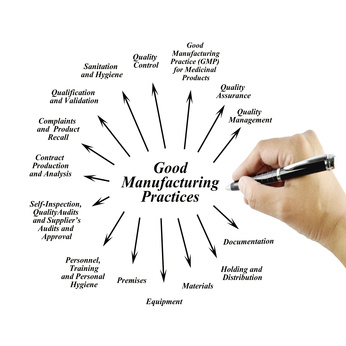What is GMP?
The GMP acronyms signify “Good Manufacturing Practices”. In general, they are the practices required for the good performance and especially for being in accordance with the guidelines recommended by agencies in United States, Canada, Europe, China and others countries for the manufacturing and/or sale of food, drugs, pharmaceutical products.
The GMP was been created to ensure the quality of drugs and to avoid possible contaminations.
For example, the quality control system of a pharmaceutical laboratory has to include all the manufacturing process, from the raw material for manufacturing, until delivery including the packaging, the storage, and the transport.
Who is the GMP for in the pharmaceutical sector?
 Basically, it affects to everybody at any stage.
Basically, it affects to everybody at any stage.
GMP regulates data registers, staff qualifications, hygiene, cleaning, equipment checking, process validation…. As well as any documentation of each aspect of the development process, analysis, production, logistic that allow the correct product traceability.
GMP can be applied to any equipment that is used to create drugs or pharmaceutical products among others. Regarding industrial sterilization in pharmaceutical sector, any equipment such as moist heat sterilizers, dry heat ovens, superheated water or ethylene oxide sterilizers, must respect the Good Manufacturing Practices – GMP.
GMP for sterilization processes
It is important to know the sterilization processes as well as the equipment operations. Every sterilization process should be validated.
The main points to be taken into account are the following one:
- The Equipment and installations have to be adequate and qualified.
- The validity of the process should be verified at scheduled intervals at least once a year or when the equipment has been modified.
- Always be kept the records with results who demonstrate that the physical measurements and by biological indicators are the appropriate for an effective sterilization.
- For an effective sterilization, the materials have to be treated with the suitable sterilization process.
- Validated loading patterns should be established for all sterilization processes.
- The biological indicators should be stored and used according to the manufacturer's instructions and their quality checked by positive controls. Strict precautions should be followed for to avoid the contamination of the materials to sterilize.
- There has to be a clear means of differentiating products which have not been sterilized from those which have, using a clearly labelled with the material name, the batch number, etc.
- Sterilization records should be available for each sterilization for each sterilization.
Let’s have a look on what to know about GMP, according to the sterilization process.
Sterilization by Heat
Each sterilization cycle should be recorded on a time and on a temperature graph with a large scale or with suitable accuracy.
Chemical or biological indicators should not take the place of physical measurements.
The time, for the entire load to reach the required temperature before measurement of the sterilization time period, must be determined for each type of load to be processed.
It is necessary to take precautions during cooling after the high temperature phase, to avoid contamination of sterilized load.
What to know about GMP for the 2 main sterilization methods by heat:
- Sterilization moist heat (Pure steam and Superheated water sterilization,...)
Both temperature and pressure should be used to monitor process. The control instrumentation has to be normally be independent of monitoring instrumentation and recording charts. It is necessary that the system and cycle faults should be registered by the system and observed by operator.
It is essential to be sure that the steam used for sterilization is of suitable quality.
- Sterilization by dry heat (Depyrogenation oven)
The process used should include air recirculation within the chamber and the presence of a positive pressure in order to prevent the entrance of a non-sterile atmosphere.
Ethylene Oxide sterilization – ETO
This sterilization process should only be used when the other processes are not the correct for the type of material to sterilize.
The validation process has to show that there is no negative effects on the product to sterilize and that the conditions and time for degassing phase allow to reduce any residual gas.
Before gas exposure, materials should be brought into equilibrium with the humidity and temperature required by the process.
Each sterilization cycle should be monitored with suitable biological indicators or by parametrical release. The information obtained have to be part of the batch record.
It is necessary to record for each sterilization cycle:
- Time to have the cycle completed,
- The pressure,
- The temperature,
- The humidity,
- The gas concentration,
- The total amount of gas used,
After sterilization, the load should be stored in a chamber where the conditions of ventilation are adequate and effective for the correct elimination of gas.
Regarding RSD sterilization equipment
 All our industrial sterilizers are designed and manufactured in accordance with the GMP. It is an important point that demonstrates the high quality of our equipment.
All our industrial sterilizers are designed and manufactured in accordance with the GMP. It is an important point that demonstrates the high quality of our equipment.
Our company, manufacturer of sterilization equipment, takes charge to design and manufacture sterilization equipment that respect all quality normatives and of good practices.
Together with safety, quality should be first.
Trust on us for your industrial sterilization projects: Pure steam, Superheated water, Ethylene Oxide sterilizers and Depyrogation oven.
RSD is an engineering company specializing in sterilization processes.
Contact us for further information.
